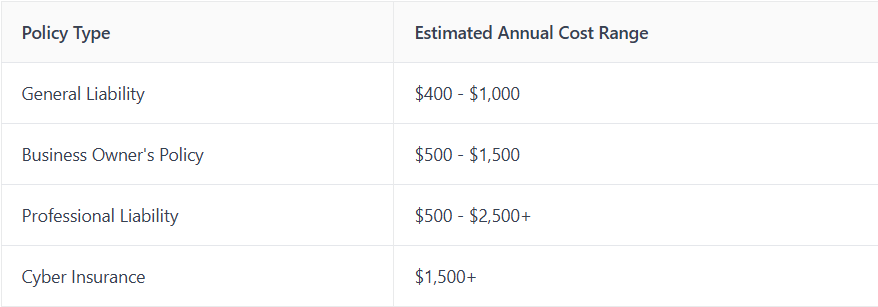
So, you're wondering about the cost of business insurance. It's a question a lot of small business owners ask, and honestly, there's no single dollar amount that fits everyone. Think of it like buying a car – the price depends on a bunch of things. Your business is unique, so its insurance needs and costs will be too. We'll break down what goes into the price tag for business insurance, so you can get a clearer picture.
Key Takeaways
- The cost of business insurance isn't a fixed price; it changes based on your specific business. Things like what you do, how big you are, and where you're located all play a part.
- General liability insurance is often the first type of business insurance small businesses get, and it's usually the most affordable, averaging around $42 a month.
- A Business Owner's Policy (BOP), which combines general liability and commercial property insurance, is a popular and cost-effective choice for many small businesses, costing about $57 per month on average.
- Several factors influence your insurance premium, including your business's size, revenue, years in operation, claims history, and even its legal structure.
- You can often save money on business insurance by bundling different policies with the same provider, making safety improvements to your workplace, and regularly checking if your coverage still fits your business needs.
Understanding Small Business Insurance Costs

Figuring out how much small business insurance will cost can feel like a puzzle. There's no single price tag because every business is unique. Think of it like buying a car – the final price depends on the make, model, features, and even where you live. The same goes for business insurance. The actual amount you'll pay is influenced by a bunch of different things.
Average Cost of Business Insurance Policies
While there's no one-size-fits-all answer, we can look at some averages to get a general idea. For instance, a basic General Liability policy, which covers things like customer slip-and-fall accidents, might run you around $42 a month, or about $500 a year. Many small businesses find it makes sense to bundle this with commercial property insurance into a Business Owner's Policy (BOP). This package deal often costs around $57 per month, or $684 annually, and it's a popular choice for its affordability and broad protection.
Here's a quick look at some typical monthly costs for common policies:

Keep in mind these are just averages. Your specific costs could be higher or lower.
Factors Influencing Your Business Insurance Premium
So, what makes one business pay more than another? Several key factors come into play. Your industry is a big one; a construction company faces different risks than a freelance graphic designer. The size of your business, including your annual revenue and the number of employees you have, also plays a significant role. If your business has been around for a while and has a history of making claims, that can also affect your premium. It's all about how the insurance company assesses the risk involved in insuring your specific operation.
Insurance providers look at your business's unique characteristics to determine your premium. This includes everything from the type of work you do to how long you've been operating and your past experiences with insurance claims. The goal is to get a clear picture of potential risks.
How Industry Affects Insurance Rates
Your industry is a major driver of insurance costs. Businesses in fields with higher inherent risks, like construction or manufacturing, typically pay more for insurance than those in lower-risk sectors, such as consulting or online retail. This is because the potential for accidents, injuries, or property damage is greater in certain industries. For example, construction companies might see monthly premiums ranging from $60 to $250, reflecting the hands-on nature and potential hazards of the job. It's why getting a personalized quote is so important; industry-specific risks are a big part of the calculation. You can get a good overview of how to compare quotes by checking out a business insurance quotes guide.
Key Factors That Determine Business Insurance Premiums
So, you're wondering what makes your business insurance bill go up or down? It's not just some random number. Insurance companies look at a bunch of things to figure out how much risk you represent. Understanding these factors can help you get a clearer picture of your costs and maybe even find ways to save.
Business Size and Revenue
Think about it: a bigger operation usually means more potential for things to go wrong. If your business has a lot of employees, there are more people who could potentially get hurt on the job. Likewise, if your business pulls in a lot of money each year, the potential financial hit from a lawsuit or property damage could be much larger. Insurers see this and adjust your premium accordingly. A small shop with one owner is going to be viewed differently than a company with fifty employees and millions in sales.
Years in Business and Claims History
How long have you been running the show? And more importantly, how many times have you had to file an insurance claim? If you've been in business for a while and have a clean record with no claims, that's generally a good sign for insurers. It suggests you're a stable business that knows how to manage risks. On the flip side, a history of frequent claims can make insurers nervous. They might see you as a higher risk, and that can lead to higher premiums. It's like driving – a spotless driving record usually gets you better rates than someone who's had a few accidents.
Business Structure and Location
Where your business is physically located can play a big part. Is your shop in an area known for high crime rates, making theft a bigger concern? Or is it in a region prone to natural disasters like floods or wildfires? These environmental and societal factors can influence your premium. The way your business is set up legally also matters. Whether you're a sole proprietor, partnership, or corporation can affect the types of risks you face and, consequently, your insurance costs.
The physical location of your business isn't just about foot traffic; it can directly impact your insurance rates due to local crime statistics and the potential for natural disasters. Insurers assess these environmental risks when calculating your premium.
Common Types of Business Insurance and Their Costs
So, you're wondering about the price tag on different kinds of business insurance? It's a fair question, and the answer isn't a simple number. It really depends on what your business does, how big it is, and what kind of protection you're looking for. Let's break down some of the most common types and what you might expect to pay.
General Liability Insurance Costs
This is often one of the first policies business owners look into. General liability insurance is there to protect you if someone gets hurt on your property or if your business operations accidentally damage someone else's property. Think about a customer slipping and falling in your store, or an employee accidentally breaking a client's valuable item. This insurance can help cover the costs of legal fees, medical bills, or repair expenses.
For many small businesses, the cost for general liability insurance can fall somewhere between $400 and $1,000 per year. It's usually one of the more affordable options out there.
Business Owner's Policy (BOP) Pricing
A Business Owner's Policy, or BOP, is a neat package deal. It typically bundles general liability insurance with commercial property insurance. This means you get protection for both liability claims and for things like damage to your office space, equipment, or inventory due to things like fire or theft. Because it combines two major coverages, it's often a more cost-effective way to get protected compared to buying those policies separately.
Prices for a BOP can vary, but you might see them starting around $500 to $1,500 annually, depending on your business's specific needs and risks.
Professional Liability and Cyber Insurance Expenses
These two cover different, but equally important, areas.
Professional Liability Insurance (sometimes called Errors & Omissions or E&O insurance) is a must-have for businesses that offer advice or services. If a client claims your professional service caused them a financial loss due to a mistake or oversight, this policy helps cover the legal costs and any settlements. For businesses like consultants, accountants, or IT providers, this is pretty standard. Costs can start around $500 to $2,500 per year, but it really depends on your field and how many clients you have.
Cyber Insurance is becoming more and more important, especially if you handle customer data. It protects your business from the financial fallout of data breaches, cyberattacks, and other digital mishaps. This can include costs for notifying customers, recovering lost data, and dealing with potential lawsuits. Because cyber threats are serious and can be expensive to recover from, cyber insurance tends to be on the pricier side, often starting around $1,500 per year and going up from there based on your coverage needs and business size.
Here's a general idea of what some common policies might cost annually:

Remember, these are just ballpark figures. Your actual premium will depend on a lot of factors specific to your business.
Strategies for Managing Business Insurance Expenses
Look, nobody likes spending money, especially on things that feel like a 'just in case' expense. But when it comes to business insurance, thinking about how to manage those costs without skimping on protection is smart. It’s not about finding the cheapest option, but the best value for your business. Being proactive can really make a difference in your bottom line.
Bundling Policies for Savings
One of the easiest ways to cut down on insurance costs is to see if you can bundle your policies. If you need general liability, commercial property, and maybe even commercial auto insurance, buying them all from the same company often comes with a discount. It's like buying a package deal. Plus, if you ever have to file a claim, dealing with one insurer is usually way simpler than juggling multiple companies. It just streamlines things.
Adjusting Coverage as Your Business Evolves
Your business isn't static, so why should your insurance be? As you grow, add new services, or even downsize certain operations, your insurance needs change. It’s a good idea to review your policy at least once a year. Maybe you've got coverage for something you no longer do, or perhaps you've expanded into an area that needs more protection. Making these adjustments means you're not paying for coverage you don't need, and you're not leaving yourself exposed where you do.
Implementing Safety Improvements
This one might seem obvious, but it's worth repeating: a safer business is often a cheaper business to insure. Think about it – fewer accidents, fewer claims. This could mean anything from installing better lighting in your workspace to having clear procedures for using equipment. Even small things, like keeping walkways clear of clutter, can prevent a slip-and-fall incident. Your insurer might even offer discounts if you implement certain safety measures, like installing security cameras or fire suppression systems. It's a win-win: you protect your employees and property, and potentially lower your premiums. You can find resources on risk management to help you control business insurance costs.
Making smart choices about your insurance coverage isn't just about saving money today; it's about building a more resilient business for tomorrow. Regularly assessing your needs and taking steps to reduce risk can lead to significant long-term savings and peace of mind.
The Role of Coverage Limits in Business Insurance Pricing

Understanding Policy Limits
When you're looking at business insurance, you'll see talk about 'policy limits.' Basically, this is the maximum amount your insurance company will pay out for a covered claim. Think of it as the ceiling on your coverage. For general liability insurance, for instance, you'll often see two main limits: a 'per-occurrence' limit and an 'aggregate' limit. The per-occurrence limit is the most the insurer will pay for any single incident. The aggregate limit is the total amount the insurer will pay out over the entire policy period, usually a year. So, if you have a $1 million per-occurrence limit and a $2 million aggregate limit, the insurer will pay up to $1 million for one accident, but the total they pay for all claims during the year can't go over $2 million.
Impact of Higher Coverage Limits on Premiums
It's pretty straightforward: the more coverage you want, the more you're generally going to pay. If you opt for higher policy limits – say, $2 million per occurrence instead of $1 million – your premium will likely go up. This makes sense because the insurance company is taking on more financial risk. They're agreeing to potentially pay out larger sums if something goes wrong. It’s a balancing act, really. You want enough coverage to protect your business from a really bad day, but you don't want to pay so much for premiums that it strains your budget.
Here's a general idea of how limits can affect costs:

Choosing the right coverage limits is a big decision. Too low, and you might be left exposed if a major claim happens. Too high, and you could be overpaying for protection you don't really need. It's worth talking to an insurance agent to figure out what makes the most sense for your specific business situation. They can help you understand the risks you face and match them with appropriate coverage levels without breaking the bank.
It's not just about the maximum payout, either. Sometimes, you can adjust other parts of your policy to manage costs. For example, increasing your deductible – the amount you pay out-of-pocket before insurance kicks in – can often lower your premium. However, you've got to be sure you can actually afford to pay that higher deductible if you ever need to make a claim. You don't want to save a little on premiums only to be unable to cover the deductible when disaster strikes.
Why Business Insurance is a Crucial Investment
Look, running a business is already a juggling act, right? You're trying to keep customers happy, manage your team, and make sure the bills get paid. The last thing you need is some unexpected event throwing a wrench into everything. That's where business insurance comes in. It's not just another expense; it's like a safety net for your hard work.
Protecting Against Unexpected Financial Losses
Think about it. What happens if a pipe bursts and floods your office, ruining equipment? Or if a customer slips and falls on your property and decides to sue? These aren't everyday occurrences, but when they do happen, the costs can be huge. We're talking about repair bills, medical expenses, and legal fees that could easily put a small business out of business. Insurance helps cover these big, scary costs so you're not left trying to figure out how to pay for a disaster out of pocket.
• Property Damage: Covers damage to your building or equipment from things like fire, storms, or theft.
• Liability Claims: Protects you if someone gets hurt on your premises or if your product or service causes harm.
• Legal Defense: Pays for lawyers and court costs if your business is sued.
Without insurance, a single major incident could wipe out years of effort and savings. It's about having a plan for when things go wrong, because they sometimes do.
The Value of Business Insurance as a Safety Net
Having the right insurance means you can sleep a little better at night. It gives you peace of mind knowing that you've got protection in place for a variety of risks. This allows you to focus on growing your business and serving your customers, rather than constantly worrying about what might happen. It's an investment in the stability and longevity of your company. Different types of insurance cover different risks, so it's important to figure out what makes sense for your specific business.
• General Liability: Covers basic third-party claims like bodily injury or property damage.
• Professional Liability: Protects against claims of negligence or errors in your professional services.
• Cyber Liability: Helps cover costs related to data breaches and cyberattacks.
Ultimately, business insurance is there to help keep your business afloat when the unexpected strikes. It's a smart move to protect what you've built.
So, What's the Bottom Line on Small Business Insurance Costs?
Look, figuring out the exact price tag for small business insurance isn't a simple math problem. It really does depend on a bunch of things specific to your business – like what you do, where you're located, and how big you are. We've seen that basic coverage like general liability can be pretty affordable, maybe around $42 a month. Bundling it up in a Business Owner's Policy often makes sense and costs a bit more, around $57 monthly. But remember, these are just averages. The best way to know for sure is to get quotes tailored to your situation. Taking the time to compare options and understand what you're paying for will help you protect your business without breaking the bank.
Frequently Asked Questions
How much money does small business insurance usually cost?
The price tag for small business insurance can change a lot. It really depends on what your business does, how big it is, and where it's located. For instance, a small shop might pay around $42 a month for basic protection, while a construction company could face much higher costs due to the risks involved. It's like buying a jacket – some are cheaper, and some cost more because they offer more protection or are made for tougher conditions.
When researching how much small business insurance costs, it also helps to understand which providers consistently rank as top options for entrepreneurs. According to Forbes Advisor’s list of the best small business insurance companies, several national carriers stand out for competitive pricing, strong financial ratings, and flexible policy options that can fit businesses of all sizes. Their breakdown offers a useful benchmark when comparing quotes, evaluating coverage types, and determining what real businesses typically pay. You can review their full analysis here: Forbes
What's the average price for general liability insurance?
General liability insurance is often the first type of coverage small businesses get, and it's usually one of the more budget-friendly options. On average, you might be looking at about $42 per month, or around $500 a year. This policy helps cover you if a customer gets hurt at your business or if you accidentally damage someone's property.
What is a Business Owner's Policy (BOP) and how much does it cost?
A Business Owner's Policy, or BOP, is like a bundle deal for insurance. It usually combines general liability insurance with commercial property insurance, often at a lower price than buying them separately. For many small businesses, a BOP costs about $57 per month, or $684 annually. It's a popular choice because it covers common problems like customer injuries and damage to your business property.
Why does my business's size and revenue affect insurance costs?
Insurance companies look at how big your business is and how much money it makes because these factors tell them about your potential risks. A larger business with more employees and higher sales usually means more chances for something to go wrong, like an accident or a lawsuit. So, bigger businesses often pay more for insurance to cover those higher risks.
How can I lower the cost of my business insurance?
There are a few smart ways to potentially save money on business insurance. You can try bundling different types of insurance together with one company, which often comes with a discount. Also, making your workplace safer can lower your risk, which might lead to lower premiums. Regularly checking if your coverage still fits your business needs can also prevent you from overpaying.
Is business insurance really worth the expense?
Absolutely! Think of business insurance as a safety net. Unexpected things happen – like a fire damaging your office, a customer slipping and getting hurt, or a mistake in your work leading to a lawsuit. Without insurance, these events could cost you a fortune and even put your business out of operation. Insurance helps protect your hard-earned money and keeps your business going when tough times hit.




